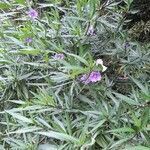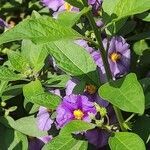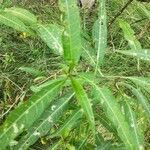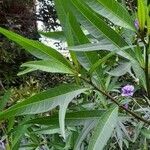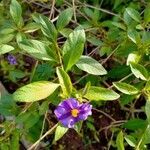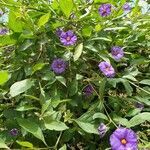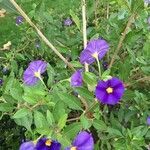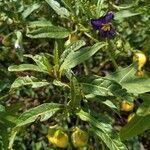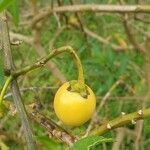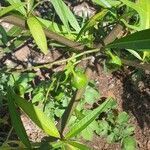Shrub to 3 m high, green, the stems often purplish, glabrous except for minute glandular hairs on young growing tips and buds, and simple hairs on seedlings and young leaves; prickles absent. Lobed leaves broadly ovate; lamina 9–38 cm long, concolorous, deeply lobed; lobes 2–13 cm long, 0.3–2 cm wide; petiole 1–4 cm long. Entire leaves lanceolate; lamina 5–20 cm long, 1–4 cm wide, concolorous; petiole 5–10 mm long. Inflorescence up to 10-flowered; peduncle to 4 cm long; rachis 5–15 cm long, often forked; pedicels 1.5–3 cm long. Calyx 4–6 mm long; lobes triangular, 2–3 mm long, slightly enlarged in fruit. Corolla rotate, 30–50 mm diam., deep purple-blue; lobes notched. Anthers 3–4 mm long. Fruiting axis 10–20 cm long. Berry ellipsoid to ovoid, 15–20 mm diam., yellow to orange-yellow. Seeds 2–2.5 mm long, reddish brown. Stone-cell granules usually 2–2.5 mm long.
Shrubs to 3 m tall; pubescence of simple hairs, soon glabrescent. Stems glabrous except for minute pubescence on young tips and buds. Leaves unequal paired, lobed and entire often on same plant; petiole of lobed leaf ca. 1-1.5 cm, that of entire leaf 0.5-1 cm; blade of lobed leaf broadly ovate, deeply pinnately 3-5-parted, 12-17 × 6-13 cm; blade of entire leaf lanceolate, 10-20 × 1.5-3 cm. Inflorescences terminal, axillary, or extra-axillary, scorpioid-racemose, ca. 8 cm; peduncle short or obsolete. Pedicel 1.5-3 cm. Calyx 5-7 mm; lobes deltate, 2-3 mm, leathery, apex mucronulate. Corolla blue-purple, rotate, 2-2.5 cm; lobes semirounded, notched. Filaments subulate; anthers oblong, 3-4 mm. Style ca. 8 mm. Berry orange-yellow, ovoid or ellipsoid, ca. 3 × 2.5 cm, pendulous. Seeds subovate, ca. 3 × 2 mm, compressed. Fl. Apr-Jun, fr. Jul-Sep.
An erect shrub. It is soft wooded. It can be 3 m tall. It can spread 2-3 m wide. It has bluish-purple leaves. It is short lived. It becomes spreading and straggly with age. The leaves are lobed and 30 cm long. They are deeply divided and dark green. The flowers are deep purple-blue with wavy edges. The flowers are larger than Solanum aviculare. The flowers are 5 cm across. The fruit are round and green. They are 2-3 cm across. They change to yellow-orange on maturity.
Similar in habit to S. aviculare but differing in purplish stems and darker If-veining. Corolla rotate, up to 5 cm. diam., blue-purple; lobes c. 1/2 length tube, margins flat, apices emarginate. Seeds 2·2-2.5 mm. long. Baylis (loc. cit. 639) gives: n = 46, average pollen-grain diam. 36-42 µ, stone-cell masses in ripe fr. conspicuous, mostly as large as or larger than the seeds.
